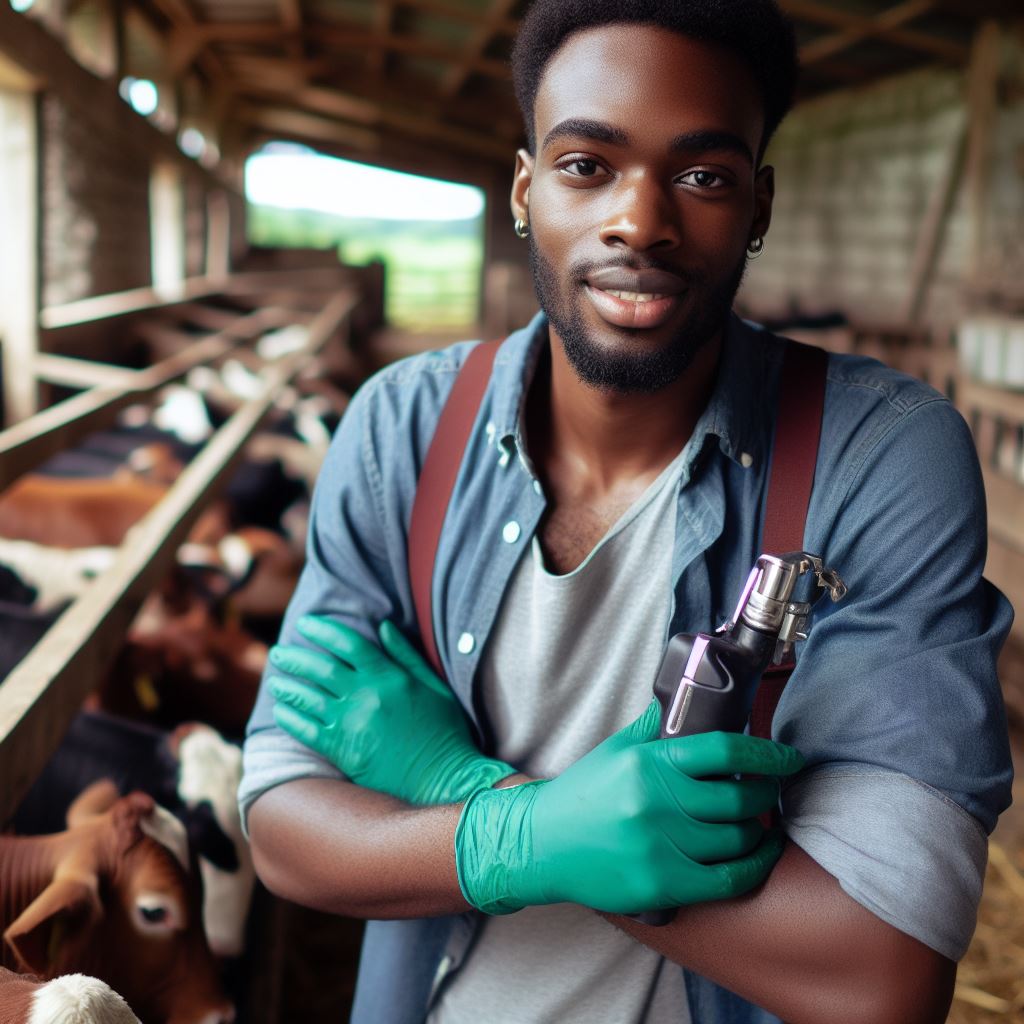Introduction
Traditional and Modern Techniques in Aquaculture Education: Aquaculture in Nigeria holds immense significance, addressing food security and economic development.
Traditional techniques, deeply rooted in local practices, coexist with modern methods, incorporating technological advancements.
The country’s reliance on aquaculture is paramount, contributing significantly to the nutritional needs of its growing population.
Traditional techniques, passed down through generations, reflect cultural practices that sustain local communities.
In contrast, modern aquaculture embraces cutting-edge technologies, optimizing production efficiency and yield.
These methods involve controlled environments, advanced equipment, and scientific principles, elevating aquaculture to a sophisticated industry.
Traditional techniques often involve pond culture, utilizing natural resources and local knowledge.
These time-tested methods, although effective, face challenges in meeting the escalating demand for fish.
Modern techniques address this by integrating innovations such as recirculating aquaculture systems and genetic improvements for enhanced productivity.
The synergy between traditional and modern approaches is pivotal for a sustainable aquaculture education.
By combining the wisdom of traditional practices with the precision of modern technologies, a holistic and adaptive curriculum can be developed.
This integration bridges the gap between conventional wisdom and contemporary advancements, providing students with a comprehensive understanding of aquaculture.
The curriculum must emphasize the coexistence of these techniques, acknowledging their respective strengths and limitations.
As Nigeria navigates the complex landscape of aquaculture, education becomes the linchpin for success.
By fostering an inclusive learning environment that incorporates both traditional and modern techniques, the nation can cultivate a skilled workforce capable of driving innovation and ensuring the resilience of its aquaculture industry.
Traditional Techniques in Aquaculture
In order to fully understand the integration of traditional and modern techniques in aquaculture education, it is important to delve into the history and origins of traditional aquaculture techniques in Nigeria.
History and Origins
Traditional aquaculture techniques in Nigeria have a rich history dating back centuries.
The practice of aquaculture can be traced back to ancient civilizations, where ingenious methods were developed to rear fish in inland waters.
These traditional techniques have been passed down through generations, allowing Nigerians to sustainably cultivate aquatic organisms for food and livelihoods.
The knowledge and expertise gained from these traditional practices formed the foundation for aquaculture education in the country.
Examples of Traditional Techniques
Various traditional techniques are employed in aquaculture in Nigeria, some of which include:
- Pond Culture: This technique involves rearing fish in specially constructed ponds, providing a controlled environment for their growth.
- Cage Culture: In this method, fish are reared in cages submerged in natural water bodies like lakes or rivers.
- Rice-Fish Farming: This integrated farming system involves the simultaneous cultivation of rice plants and fish in the same field.
- Ditch or Canal Culture: Aquatic organisms like fish and shellfish are cultivated in irrigation ditches or canals alongside crops.
These traditional techniques have been refined over time to optimize production and increase yields.
Benefits and Limitations
The integration of traditional techniques in aquaculture education offers several benefits:
- Cost-Effective: Traditional techniques are often low-cost and accessible, making them viable for small-scale farmers.
- Localized Knowledge: These techniques have been developed and adapted to specific local conditions, resulting in high adaptability and efficiency.
- Sustainability: Traditional techniques focus on natural resource management and promote sustainable practices.
- Preservation of Cultural Heritage: Incorporating traditional techniques allows for the preservation of cultural heritage and indigenous knowledge.
However, traditional techniques also have their limitations.
Limitations
- Productivity Constraints: Traditional techniques may have lower production levels compared to modern methods due to limited technologies.
- Limited Scaling: Scaling up traditional techniques to meet growing demands can be challenging, especially for commercial purposes.
- Quality Control: Ensuring consistent product quality and meeting market standards may be more difficult with traditional techniques.
- Environmental Impact: Depending on the practices employed, traditional techniques can have negative environmental impacts, such as water pollution.
In fact, traditional aquaculture techniques in Nigeria have a deep-rooted history and bring a range of benefits and limitations to aquaculture education.
By integrating traditional knowledge with modern techniques, a comprehensive and sustainable approach to aquaculture can be achieved.
Read: Admission Requirements for Animal Physiology Courses in Nigeria
Modern Techniques in Aquaculture
In the dynamic world of aquaculture education, integrating traditional wisdom with cutting-edge techniques is crucial.
This section delves into the realm of modern aquaculture, unraveling the advancements that shape the future of this vital industry.
The advancements and innovations in modern aquaculture techniques
Exploring the forefront of innovation, modern aquaculture embraces a myriad of techniques to enhance efficiency and sustainability.
Technological marvels like recirculating aquaculture systems (RAS) redefine the way we cultivate aquatic life.
RAS, a beacon of progress, facilitates water reuse, minimizing environmental impact while maximizing resource efficiency.
This transformative technology ensures optimal conditions for aquatic species, fostering healthier growth and minimizing waste.
The use of technology, such as recirculating aquaculture systems (RAS) and biofloc technology
Biofloc technology, another star in the modern aquaculture constellation, capitalizes on microbial communities to maintain water quality.
It offers a biosecure environment, reducing the need for external chemicals and ensuring a more organic approach to aquaculture.
The benefits and limitations of modern techniques
While modern techniques promise unprecedented benefits, it’s crucial to acknowledge their limitations.
The initial investment for RAS setups, for instance, can be substantial, posing a barrier for small-scale farmers.
Striking a balance between innovation and accessibility is key for widespread adoption.
Despite challenges, the benefits of modern techniques are undeniable.
Increased yields, reduced environmental impact, and improved disease management contribute to the sustainable growth of the aquaculture sector.
Transform Your Career with Expert Guidance
Get personalized mentorship consulting that’s tailored to your unique path. Our expert advice is actionable and exclusive.
Get StartedThese innovations empower educators to instill a forward-thinking mindset in the next generation of aquaculturists.
In short, the integration of modern techniques into aquaculture education marks a paradigm shift.
By embracing innovation while staying mindful of limitations, educators pave the way for a harmonious coexistence of traditional knowledge and contemporary advancements.
This fusion holds the key to a thriving and sustainable future for aquaculture.
Read: Impacts of Climate Change on Fisheries Studies in Nigeria
Challenges in Integrating Traditional and Modern Techniques
In the process of integrating traditional and modern techniques in aquaculture education, several challenges need to be addressed.
These challenges can hinder the smooth integration and implementation of both approaches.
In this section, we will identify the barriers and obstacles, discuss the socio-cultural factors influencing resistance to change, and address the economic implications and feasibility.
Identifying Barriers and Obstacles
- Lack of awareness and understanding about the benefits of integrating traditional and modern techniques.
- Resistance from traditional practitioners who are reluctant to adopt new methods.
- Limited availability of resources and funding for implementing new approaches.
- Inadequate technical knowledge and skills to bridge the gap between traditional and modern techniques.
- Regulatory barriers and restrictions that prevent the integration of certain practices.
Socio-cultural Factors Influencing Resistance to Change
- Deeply rooted cultural beliefs and practices that prioritize traditional methods over modern techniques.
- Fear of disrupting social structures or losing cultural identity with the introduction of new approaches.
- Lack of trust and skepticism towards modern techniques due to their association with external influences.
- Reliance on traditional knowledge as a source of pride and resistance to adopting foreign methods.
- Inter-generational conflicts between older generations who value tradition and younger generations open to innovation.
Economic Implications and Feasibility
- High upfront costs associated with modern techniques, such as advanced equipment and infrastructure.
- Limited access to capital and financing options for small-scale traditional aquaculture practitioners.
- Uncertainty about the potential returns on investments in integrating traditional and modern techniques.
- Market demand and acceptance of products produced through traditional or modern methods.
- Unequal distribution of benefits, as modern techniques may favor larger commercial operations, leaving traditional practitioners marginalized.
By overcoming these challenges, aquaculture education can benefit from the integration of traditional and modern techniques, resulting in more resilient and sustainable practices.
Embracing innovation while respecting cultural heritage is crucial for the future of aquaculture and the well-being of communities involved in this important industry.
Read: Practical Field Experiences: Animal Physiology Studies in Nigeria

Case Studies of Successful Integration
Integrating traditional and modern techniques in aquaculture education has proven to be beneficial in various real-life examples.
Let’s delve into some case studies that highlight successful integration in aquaculture farms and projects.
Case Study 1: The Integrated Aquaculture Project
The Integrated Aquaculture Project in Thailand is an excellent example of traditional and modern techniques working in harmony.
This project combines rice farming and fish culture, utilizing traditional farming knowledge alongside modern aquaculture practices.
The farmers employ the System of Rice Intensification (SRI), a traditional method that focuses on organic and sustainable rice cultivation.
They have successfully integrated fish rearing into the rice fields, creating a mutualistic relationship between the crops and the fish.
The approach used in this project involves carefully managing water levels, ensuring optimal conditions for both rice and fish.
The farmers have adopted modern tools such as water quality monitoring devices and automated feeders to enhance productivity and efficiency.
This integration has resulted in numerous benefits for the farmers and the industry. The yield of both rice and fish has increased significantly, providing higher incomes for the farmers.
Moreover, the mutually beneficial relationship between the crops and fish leads to natural pest control and organic fertilization, reducing the need for chemical inputs.
This sustainable and integrated approach has garnered international recognition.
Case Study 2: Integrated Shrimp and Mangrove Forest Aquaculture
In Vietnam, the integration of shrimp farming and mangrove forest restoration has been successfully implemented.
This project aims to restore mangrove forests while simultaneously cultivating shrimp in a sustainable manner.
The farmers have employed techniques such as integrated mangrove-shrimp farming, where shrimp ponds are constructed within the mangrove forests.
The mangroves serve as a natural filtration system, ensuring water quality and providing a natural habitat for the shrimp.
By combining both traditional and modern practices, the farmers have achieved successful integration.
They follow traditional knowledge of sustainable mangrove management, including selective harvesting and replanting.
Additionally, modern techniques such as efficient aeration systems and water quality monitoring are employed to enhance shrimp growth.
The integration of shrimp farming with mangrove forests has resulted in several benefits. It has provided additional income sources for the farmers while restoring valuable ecosystems.
The mangroves act as carbon sinks, mitigating climate change impacts, and supporting biodiversity.
This integration showcases the potential for sustainable aquaculture practices that balance ecological and economic considerations.
Case Study 3: Integrated Pond and Cage Aquaculture
In many parts of Asia, integrated pond and cage aquaculture has proven to be a successful approach.
This integration combines traditional pond culture with modern cage culture techniques to maximize productivity and utilization of resources.
The farmers construct cages within the ponds, where fish or shrimp are reared.
The excess nutrients from fish excreta are absorbed by pond crops, such as submerged macrophytes or floating aquatic plants, minimizing water pollution.
Additionally, integrated feed management strategies are employed to optimize nutrient utilization and reduce wastage.
This integration benefits both the farmers and the industry. The combined approach maximizes the utilization of available water bodies, increasing the production capacity per unit area
It also reduces the reliance on external feed inputs and minimizes the environmental footprint of aquaculture operations.
Moreover, this integration provides opportunities for diversification, allowing farmers to cultivate different species simultaneously.
In essence, these case studies clearly demonstrate the successful integration of traditional and modern techniques in aquaculture.
The strategic combination of traditional knowledge with modern tools and approaches has resulted in numerous benefits for the farmers and the aquaculture industry as a whole.
These examples highlight the potential for sustainable and innovative practices in aquaculture education.
Read: Comparing Nigerian Animal Physiology Curriculum to Global Standards
Potential Synergies and Benefits in Integration
The potential synergistic effects of integrating traditional and modern techniques
Integrating traditional and modern techniques in aquaculture education can bring about several potential synergies and benefits. These include:
When traditional and modern techniques are integrated in aquaculture education, they have the potential to create powerful synergies.
By combining the wisdom and knowledge of traditional practices with the advancements of modern technologies, students can gain a holistic understanding of the industry.
How aspects of traditional techniques, such as local knowledge and biodiversity conservation, can complement modern techniques
Traditional techniques often embody a deep-rooted local knowledge that has been passed down through generations.
This knowledge includes insights into the local environment, weather patterns, and the behavior of aquatic species.
When combined with modern techniques, this valuable information can enhance the overall effectiveness and efficiency of aquaculture practices.
Biodiversity conservation is another crucial aspect of traditional techniques that can complement modern methods.
Traditional practices often prioritize the preservation of local ecosystems and the sustainable use of resources.
Integrating these principles into modern aquaculture education can help students develop a deep sense of responsibility towards the environment and foster sustainable practices in the industry.
Integration of traditional and modern techniques also offers the potential for increased productivity in aquaculture.
Traditional methods can provide valuable insights into optimizing production systems by leveraging natural processes and adapting to local conditions.
Integrating these practices with modern technologies allows for the development of innovative and efficient production methods, leading to higher yields and improved overall productivity.
Sustainability is a critical aspect of modern aquaculture, and integration with traditional techniques can greatly contribute to achieving sustainable practices.
Traditional knowledge often emphasizes the importance of maintaining a balanced ecosystem and minimizing negative impacts on natural resources.
By incorporating these principles into aquaculture education, students can become stewards of responsible and sustainable aquaculture, ensuring the industry’s long-term viability.
The potential for increased productivity, sustainability, and profitability in aquaculture through integration
Furthermore, integration can enhance the profitability of aquaculture operations.
Traditional techniques, being inherently adapted to local conditions, can help reduce production costs by utilizing available resources effectively.
By combining them with modern techniques, aquaculture businesses can achieve a balance between economic viability and sustainable practices, ultimately increasing profitability.
Basically, integrating traditional and modern techniques in aquaculture education offers numerous synergies and benefits.
The combination of traditional knowledge and modern technologies can lead to a comprehensive understanding of the industry and foster sustainable practices.
By exploring the potential synergistic effects, utilizing local knowledge, and embracing biodiversity conservation, aquaculture can achieve increased productivity, sustainability, and profitability.
Recommendations for Integration
Title: Integrating Traditional & Modern Techniques in Aquaculture Education: Recommendations for Successful Integration
Practical recommendations for farmers, policymakers, and stakeholders
- Foster workshops merging traditional wisdom with modern methodologies.
- Create accessible manuals merging ancestral practices with innovative technologies.
- Establish mentorship programs linking experienced farmers with novices.
- Develop demonstration farms showcasing amalgamated techniques for practical learning.
- Initiate incentive schemes encouraging adoption of integrated approaches.
- Establish collaborative platforms facilitating dialogue among stakeholders.
- Encourage mixed-culture ventures to diversify production and enhance sustainability.
Importance of capacity building, knowledge sharing, and R&D
- Capacity building ensures hands-on training and skill development.
- Knowledge sharing aids in disseminating successful integrated methodologies.
- R&D drives innovation for effective integration of diverse techniques.
- Continuous learning fosters adaptation to changing environmental and market demands.
- Collaboration between academia, industry, and farmers accelerates innovation.
- Encouraging entrepreneurship through training enhances self-sufficiency.
- Emphasize lifelong learning to keep up with evolving aquaculture practices.
Encouraging collaboration between sectors and stakeholders
- Foster partnerships between government bodies and local communities for policy implementation.
- Collaborate with NGOs to integrate indigenous knowledge into modern practices.
- Promote industry-academia alliances for comprehensive research and practical applications.
- Establish multidisciplinary task forces to address challenges collectively.
- Encourage dialogues between traditional practitioners and scientists for knowledge exchange.
- Create networks fostering mutual learning among diverse stakeholders.
- Formulate platforms for open discussions to resolve conflicts and capitalize on shared benefits.
Therefore, integrating traditional and modern techniques in aquaculture education necessitates a multifaceted approach.
Practical recommendations, emphasis on capacity building, knowledge sharing, and collaborative efforts among diverse stakeholders are pivotal for successful integration.
This holistic approach will not only address challenges but also harness the immense benefits of amalgamating traditional wisdom with modern advancements in aquaculture.
Conclusion
Integrating traditional and modern techniques in aquaculture education is crucial for sustainable development and food security in Nigeria.
We have seen that traditional techniques have been passed down through generations and have proven effective in small-scale aquaculture.
However, modern techniques offer innovative solutions that can enhance productivity and efficiency in larger-scale aquaculture operations.
By combining the strengths of both traditional and modern techniques, we can create a more resilient and productive aquaculture industry in Nigeria.
Integrating traditional and modern techniques also promotes knowledge exchange and collaboration between different stakeholders in the aquaculture sector.
This is essential for continuous learning and improvement, as well as the development of new techniques and technologies.
Furthermore, the integration of traditional and modern techniques in aquaculture education ensures that future generations are equipped with the necessary skills and knowledge to contribute to the industry.
Overall, the integration of traditional and modern techniques in aquaculture is vital for sustainable development and food security in Nigeria.
It is important for policymakers, educators, and industry leaders to encourage further exploration and investment in this field.
By doing so, we can create a thriving aquaculture industry that contributes to the economic growth and well-being of the country.




